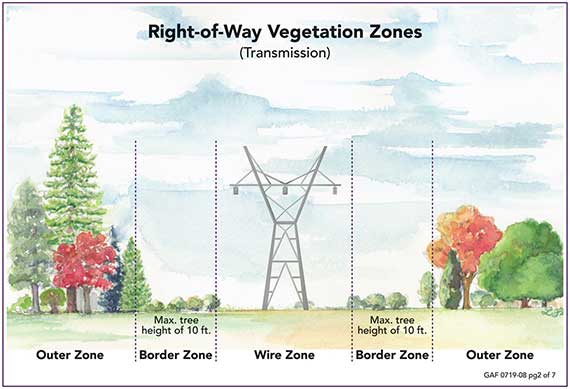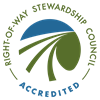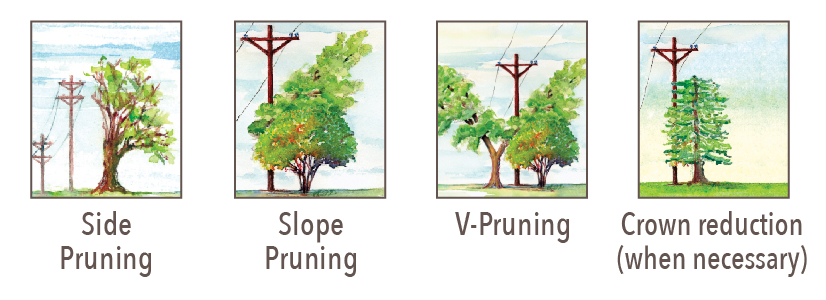Protecting trees and power lines
Our Vegetation Management team clears vegetation away from power lines, poles and transformers for your safety and to reduce fire risk. Keeping these areas clear helps prevent power outages and ensure reliable electric service. We may need to access utility easements on your property if we identify vegetation growing too close to our electrical equipment.
We partner with other organizations to maintain and protect our community’s urban forest so you may see our tree pruning contractors in your neighborhood. They use the Best Management Practices recommended by the International Society of Arboriculture and take all appropriate steps to protect your property.
Learn about our vegetation management program accreditation
If you see trees that are interfering with power lines, call us at 1-866-473-9582.
To maintain the reliability of the electrical system and reduce the risk of wildfire, we need about 12 feet of space between tree canopies and our overhead power lines. But for fast-growing trees like mulberry or eucalyptus, we may need as much as 20 feet of clearance to prevent power outages.
Pruning process
We inspect our entire 900-square-mile service area on a 2-year cycle, and 1-year cycle for higher risk areas.
- Routine inspections provide an accurate account of tree growth. Trees growing into power lines can cause power outages and other safety hazards.
- If a tree on your property needs to be pruned, you'll be notified in person or with a door hanger before the work starts. Your permission is not required since, by law, we’re required to maintain our lines and keep them safe and hazard-free. For any questions or concerns, contact the Vegetation Planner listed on the door hanger.
- Tree crews usually are on the scene 4 to 6 weeks after a Vegetation Planner has inspected an area. Things may arise that alter scheduling. If the work needed is urgent, crews may arrive in a matter of days instead of weeks.
Tree pruning methods
We use the best vegetation management practices recommended by the International Society of Arboriculture. Directional pruning methods are used to encourage trees to grow away from electric wires.
Sometimes the situation requires pruning only one side of the tree, pruning one side more than the other or pruning just the middle of the tree. These variations are known as side pruning, slope pruning or “V pruning.” Trees may appear unbalanced at first, but a healthy tree will cope with the changes and its appearance will soften over time.
We make sure that all tree crews follow recommendations to disinfect their tools between trees and between job locations if there is a known disease in the area.
Tree removal
We cannot use directional pruning on some trees, like redwoods or palms, because they grow straight up from a “central leader.” When these trees are planted under power lines, we must cut back the crown or remove the tree.
We remove trees to protect your property from potential hazards and to prevent tree-related power outages. If we need to remove a tree on your property because of a potentially hazardous situation, we will contact you ahead of time. We will not charge you for the removal.
Vines
Vines growing on utility poles are dangerous to line workers and the public. If the vines grow into the high voltage wires, they can conduct electricity to the ground. They also pose a climbing hazard for any line worker performing maintenance on electric, phone or cable lines. We remove vines from poles during each routine tree-trimming cycle. You can help by keeping vines from growing near poles.
Ground-level transformers
We ask that you avoid planting any kind of vegetation within 8 feet of our green metal boxes that contain pad-mounted transformers. Please don’t let any invasive plants grow over the top of the transformer, which can prevent us from opening the door. For the safety of our line workers, we will remove any vegetation that poses a hazard. Keep the space around these transformers clear to help SMUD crews restore power to you and your neighbors more quickly during an outage.
Vegetation management work is done by SMUD crews and outside contractors. All tree pruners working on our behalf are certified by Cal/OSHA to perform line clearance work near high-voltage power lines.
Our contractors manage daily tree pruning work and SMUD supervisors are in the field to conduct quality audits and respond to any customer concerns.
For more information, please call:
- Mountain F Enterprises | 1-530-719-7999
- Rancho Tree Service | 1-279-237-1112
- Utility Tree Service | 1-279-280-0011
Worker identification
SMUD contractor vehicles will display the SMUD logo and their company name. If you have questions about the work being done in your neighborhood, call the SMUD Vegetation Management office at 1-866-473-9582.
Transmission lines carry high voltages, so we need to allow more space between trees and these types of lines. This allows us to keep the public, our workers and our environment safe while maintaining reliability.
Only low-growing ground covers and shrubs with mature heights of less than 10 feet can be planted in the right of way (extending 10 feet outside of lines).
If you are planning any type of building or property improvement in the transmission line right of way, you’ll need to file an application with SMUD’s Real Estate Services group. Call us at 1-888-742-7683 for more information.
We are also required to maintain access roads to get to our equipment along transmission lines. Please be sure not to build or plant anything that would interfere with use of the access roads.

If our crews need to remove a tree from your property to ensure safety and reliability for you and your neighborhood, you may qualify for a free replacement tree from us.
We offer free replacement trees selected both for their natural beauty and their lower height so that they will not eventually grow to interfere with power lines in the future.
We know how disappointing it can be to lose a tree. Our tree replacement program helps to restore or enhance the beauty of your property while enhancing reliability and safety.
Replacement tree care
With regular attention, your new trees can be expected to grow 20-60% faster in their first five growing seasons.
Watering
For newly planted trees, water twice per week for the first 2 months, or until seasonal rains start. Water 3 times per week if you plant during summer. In general, keep the root ball moist, but do not overwater. To do a simple test, dig up a handful of soil from 6 inches deep near the tree. Form it into a ball. If the ball crumbles, the soil is too dry. If it drips water, it is too moist.
Mulching
Keep 2 to 4 inches of mulch around your new trees to help control weeds and moisture evaporation.
Weeding
Keep weeds and other plants at least 36 inches away from tree trunks to allow for healthy growth. Do not use a lawnmower or weed trimmer in this area. Instead, pull weeds by hand.
Fertilizing
Fertilize your new trees annually. A tablespoon of ammonium sulfate or high-nitrogen fertilizer is recommended for trees under 3 years old. Water thoroughly and follow package instructions for the right amount of fertilizer.
Pruning and training
We recommend that you do not prune your new trees for the first 2 years after planting. After that, follow these simple suggestions for pruning:
- Use clean, sharp tools.
- First remove dead or damaged limbs. Then remove the weakest of any crossing limbs, as well as shoots or water sprouts.
- Cut outside the area where the branch joins the trunk (the branch bark collar).
- Never prune the tops of your new trees.
- Whatever cannot be safely reached from the ground or a short stepladder should be left to a tree professional.
You can increase your property value, prevent costly and sometimes unsightly maintenance pruning, and lower the risk of damage to your home and property by choosing the right tree and putting it in the right place. For safety and reliability, some trees should never be planted anywhere near power lines.
Do your research and consider these safe planting tips when planting near power lines:
- Palm tree species and redwood trees should never be planted near power lines. They can be extremely flammable if they come in contact with power lines and are often removed by utilities.
- Trees should grow under 15 ft. at mature height.
- Call 811 at least two (2) business days before you dig to protect yourself and others from unintentionally hitting underground utility lines.
- Consult with the Sacramento Tree Foundation for assistance in placing trees.
Helpful links
Which overhead power lines do you need to prune?
Vegetation must be cleared for all high-voltage overhead power lines. In most cases, these are the lines highest on the power poles. The words, "High Voltage" are marked on poles or cross-arms carrying high-voltage lines. Low-voltage (secondary) lines, below the transformer, need less maintenance and are usually cleared during routine pruning cycles. Service lines to your house are also lower voltage. They are only pruned if there is a heavy strain or abrasion and can be safely worked around by customers or their contractors.
How far will you prune my trees from the wires?
The amount of pruning we do depends on the tree's structure, growth rate, how much it tends to sway in the wind and how much sag there is in the line that's affected. Other factors include the tree species, environmental factors, irrigation, proximity to the line, voltage of the line and line configuration. We need to maintain a reasonable margin of safety beyond the minimum clearance requirement.
We also meet a range of legal guidelines:
- California Public Utilities Commission General Order 95, Rule 35
This calls for a minimum 18-inch clearance between vegetation and energized conductors (wires) carrying more than 750 volts.
- Public Resource Code Section 4293
This calls for a minimum clearance of 4 feet between vegetation and energized conductors (wires) carrying more than 750 volts, and mainly covers areas where the California Department of Forestry and Fire Protection (CalFire) is the direct protection agency (generally non-urban areas).
- Public Resource Code Section 4292
This calls for a cylindrical clearance 10 feet around certain poles and extending 8 feet above ground level (see illustration). As is the case with Public Resource Code 4293, this code covers areas where CalFire is the direct protection agency.
Utilities often need to exceed minimum clearances to account for re-growth and for all potential weather/climate conditions that can affect the interplay of vegetation and wires. Time between pruning cycles is another consideration in determining proper clearances.
Can I do the work myself?
Pruning trees around high-voltage power lines is inherently risky. People who lack proper training put themselves and others at grave risk of electrocution. Play it safe. Make sure that anyone pruning vegetation around power lines on your property has the right training and the right tools to do the job. For details, check out Title 8 of the California Code of Regulations, Article 37 and Article 38: Electrical Safety Orders.
Observe the 10-foot rule: If a tree you want to remove or prune is within 10 feet of a high-voltage line, call us at 1-866-473-9582. We'll come out to inspect the line at no charge to you to make sure it's safe for you to move forward. If clearing is needed before you can safely proceed, we will perform a "safety prune" to create a safe space in which you or a paid tree contractor may work. In such cases, site cleanup will be your responsibility.
Does SMUD employ certified arborists?
Yes. We employ more than 2 dozen certified arborists, including all of our supervisors, most Vegetation Planners and other members of our team. All of our certified arborists are professional members of the International Society of Arboriculture (ISA) and take ongoing professional courses to maintain their certification. Our supervisors are all members of the Utility Arborist Association (UAA).
What about tree houses?
If any part of a tree house is within 10 feet of a power line, it's too close. Don't put your kids at risk of electrocution. Keep tree houses and other play structures far away from overhead power lines.
Wouldn't it be better just to put all power lines underground in order to avoid pruning?
Easier said than done. Underground power lines are common in new developments, but to do it in existing neighborhoods requires removing all trees and vegetation along the line or have the roots trenched through in order to bury the underground cable. New easements also need to be negotiated. The whole process carries a high price tag. In the event of outages, power takes longer to restore with underground cabling.
Before you dig on your property, find out where underground facilities may be by calling 811 or visiting call811.com.
What about downed power lines?
Safety first. Always stay clear of downed power lines. Call us at 1-888-456-7683 to report downed power lines, or call 911. During emergency efforts to restore power, uprooted trees and/or broken branches may be removed from power lines by our crews or our tree contractors. Once vegetation has been cleared from the lines, the final site cleanup of storm-damaged trees is the responsibility of the property owner.
When outages occur, we are responsible for restoring electric service. For phone or cable service, be sure to contact your appropriate supplier.
Accreditation and awards

Sacramento has been recognized by the National Arbor Day Foundation as a Tree City USA.
SMUD has been a perennial winner of the Tree Line USA award.




